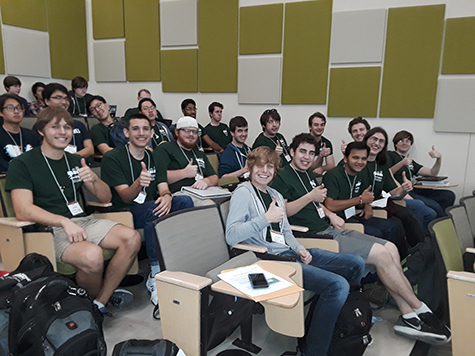 Twelve students from the Department of Computer Science and Engineering at Texas A&M University participated in the Association for Computing Machinery (ACM) International Collegiate Programming Competition (ICPC) South Central USA regional competition, held Nov. 4.
Twelve students from the Department of Computer Science and Engineering at Texas A&M University participated in the Association for Computing Machinery (ACM) International Collegiate Programming Competition (ICPC) South Central USA regional competition, held Nov. 4.
The South Central USA region covers schools from Texas, Oklahoma and Louisiana. The students from the department traveled to Baylor University to compete, though there were a total of four locations across the region.
Over 70 teams participated in the event. Texas A&M was represented by four teams who ultimately finished third, fourth, fifteenth and sixteenth in the region overall. Dr. John Keyser, a professor in the department, served as coach for the students. A team from The University of Texas at Austin placed first, with a team from The University of Texas at Dallas placing second overall.
Teams are ranked based on how many problems they solve, and then on the time it takes to solve them. These competitions are very difficult, but are also very rewarding for the students involved.
Seniors Michael Earl and Nate Leake, and junior Jordan Lamkin were the Sourcerers, who placed third overall. Junior Chase Hinesman and seniors Brian Maule and Christopher Rech were the Unordered Cartographers, who placed fourth overall. Senior Nathan Villanueva, sophomore Jack Graham and graduate student Bhavesh Munot were the Texas A&M Maroon team, who placed fifteenth overall. Sophomore Giuseppe Rizzi, sophomore Luke Witt and junior Gabriel Stella were the Texas A&M White team, who placed sixteenth overall.
“My favorite aspect of ICPC is that it gives me an avenue to meet people who are as passionate about algorithms as I am,” Graham said.
To prepare for the competition, the students participated in several practice sessions for more than a month. Practices ranged from review sessions describing various algorithms and how they can be used to solve problems to running sample contests ranging from 45 minutes to five hours long. During the competition, students have to write programs that can solve problems stated precisely. The regional contest problems ranged in difficulty from easier problems such as computing a baseball player’s slugging percentage, to more difficult problems such as finding possible destinations for a robot that had bugs in its motion program.
"Competitive programming makes you challenge yourself to improve as a programmer like nothing else does,” Earl said.
The contest fosters creativity, teamwork and innovation in building new software programs and empowers students to perform under pressure. It is the oldest, largest and most prestigious programming contest in the world.